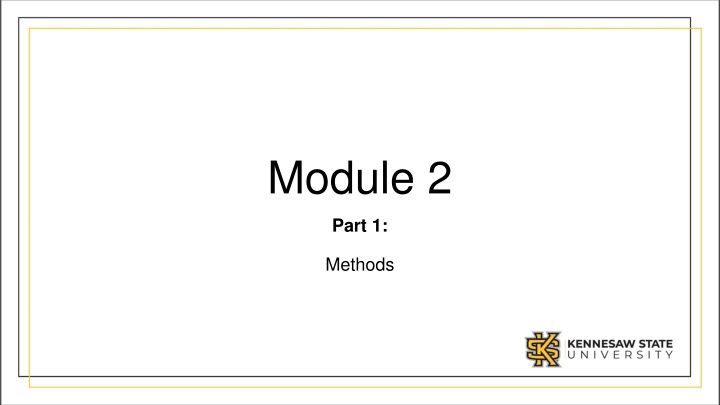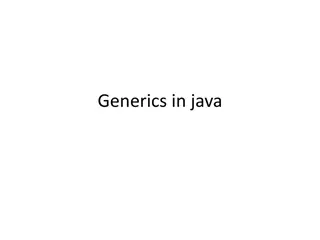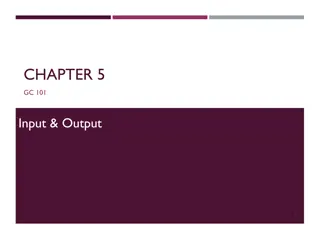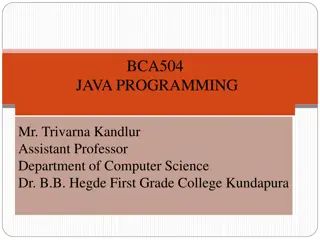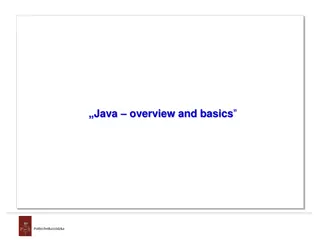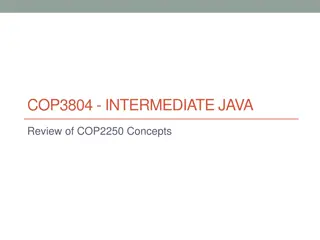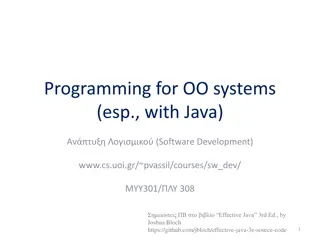Introduction to Java Methods
The concept of methods in Java programming. Methods act as black boxes containing detailed implementations for specific tasks, allowing for code organization, reusability, input parameters, and return values. Learn about declaring methods, calling methods, method returns, naming conventions, parameters, and more.
Download Presentation

Please find below an Image/Link to download the presentation.
The content on the website is provided AS IS for your information and personal use only. It may not be sold, licensed, or shared on other websites without obtaining consent from the author.If you encounter any issues during the download, it is possible that the publisher has removed the file from their server.
You are allowed to download the files provided on this website for personal or commercial use, subject to the condition that they are used lawfully. All files are the property of their respective owners.
The content on the website is provided AS IS for your information and personal use only. It may not be sold, licensed, or shared on other websites without obtaining consent from the author.
E N D
Presentation Transcript
Module 2 Part 1: Methods
Review: What is a Method? Think of a method as a black box that contains the detailed implementation for a specific task. The method may use inputs (parameters) It may return an output with a specific type.
Methods in Java Methods in Java do the same job as functions in Python. They allow you to group a block of code together, name it and allow for reuse. Both can take in parameters Both can return values
Declaring Methods You declare a method in Java using the following pattern: <return type> <name> (<parameter(s)>) { <body of method> }
Calling the Method Method Name Return Type Formal Parameter s Modifiers Method Header public static int addTwoNums (int x, int y) { return x + y; } Method Body Actual parameters (called arguments ) int result = addTwoNums (5, 2);
Method Returns The return type of a method indicates the type of value that the method sends back to the calling location. The return statement has 2 purposes: It halts execution within the method And (optionally) returns a value A method that does not return a value has a void return type A return statement specifies the value that will be returned return expression; Its expression must conform to the return type
Method Name You should name each method with a name that describes what the method is doing. e.g A method which finds the smallest number in an array? public int findSmallest(int[] theArray) { This will be helpful for you when you write larger code. It s also very helpful for the next person who ll have to maintain your code.
Parameters A method can have 0 or more parameters. If there are 0 parameters you must still put empty () s Each parameter will have: A type A name The type must match the arguments you pass when you call the method The name can be anything, but should again be relevant to what the purpose of the parameter is.
Example A method to find the length of a name: public int nameSize(String theName) { return theName.length(); } This method returns an int, because that s what a string.length() returns.
Differences between Python and Java Methods Python Java Defined using the def keyword Parameters can have default values Can return any data type Lack of return keyword makes the method return None You must declare the type of all parameters they cannot have default values Must always return the datatype in the method s header Generally should be public,sometimes will be private. Must declare what datatype they return (can be void) Methods inside the Driver class must always be static, methods in other classes generally will not be static. Can be overloaded (*More on this later )
Indentation In python all code in the body of the method had to be indented. While not strictly required in Java, you should always do this to make your code more readable: Python Java
Return types and parameter types are enforced Java requires that all types match This method will not compile because it may fail to return a string (if a==0).
Void return type A return type of void means the method will not return anything. Specifically it CANNOT return anything. Here is an example of a method which does not return anything.
Void methods can have return Void methods can have the return keyword, so long as it isn t returning any value. In this case, the return keyword is being used to signal that the method is done executing
Passing arguments & Using Return Type The number, type and order of the arguments must match the parameters in the method. In this case we are passing a single integer, so value is assigned 15 at the start of isPositive() isPositive() returns a boolean. That return value is used in an if statement in main.
Capturing Return Values Remember to capture the return value. Otherwise why did you call the method?
Python default parameters In Python you can pass default values to parameters in methods. Allows you to call the method without passing any of year, month and day. It assume you meant 2024, 1, and 1.
Java has no default parameters It s not possible to add default values to parameters in Java. No matter what, if a method has parameters, you must send it values when you call it.
Javas solution: overloaded methods Java allows you to have multiple versions of the same method. Each with different parameters.
Overloading rules You can have as many overloads as you like. Each must have different parameters. Specifically: Different number of parameters Different type parameters Different order of parameters For example, you have have: one overload which takes (int a, double b) another which takes (double a, int b) another which takes (int a, int b) another which takes (double a, double b) another which takes (char a)
Useful Example: Imagine you need to divide 2 numbers, you might do: You can call that with: divideTwoNumbers(10,3) and it ll return 3.3333. Great.
Next try: Notice Java is unhappy: We need another version of divideTwoNumbers which expects 2 doubles. Now it works.
Which one is called? The Java compiler determines which version of the method is being invoked by analyzing the parameters It will call the one which most closely matches the arguments in the call. Note: The return type of the method is not part of the signature
Which is called? float tryMe (int x){ return x + .375; } float tryMe (int x, float y){ return x*y; } // Which tryMe is called? result = tryMe (25, 4.32f);
What is the output of this code? static void B(int x) { // Built-in type argument passing x += 9; System.out.println(x); //Prints 51, because x was 42, then 9 was added. } public static void main (String[] args) { int a = 42; System.out.println(a); B(a); // Prints 51 because is call-by-value; System.out.println(a); // Prints 42 } // Prints 42
Very Important: In that last example we called method B and passed it an argument of: a a is an integer Method B has a formal parameter x which is given a COPY of the value of a Thus changes to x have no effect on a, as x was given a COPY of the value. This is true for all primitive types (int, long, float, double and even String)
